Yomi – Kingdom Of The Dead In Japan’s Native Shinto Religion
A. Sutherland - AncientPages.com - The Japanese mythological Kingdom of the Dead is often referred to as Yomi. In Japan's native Shinto religion, Yomi-no-Kuni is the Shinto underworld, as described in the Kojiki, Japan's oldest chronicle and source for many Shinto beliefs across the centuries.
The Yomi's other names include the "Land of The Dead ("Land of Darkness").
Yomotsu Hirasaka is the slope that leads to Yomi. This is Legend place in Higashiizumo, Shimane, Japan. ChiefHira - CC BY-SA 3.0
It was considered a place of darkness full of demons and evil gods who attacked and pursued all who got there.
The ruler of this terrible Kingdom was Emma-O, the judge of the dead, who lived in an underground castle made of metals and gemstones mined from the underworld.
When evil people died and came to Yomi, they were forced to wear signs around their necks with a list of their sins. Based on the sins, Emma-O pronounced his verdict over the deceased who were put before him. He punished the guilty souls and sent the innocent to earth to be reborn.
In Yomi, there were 80,000 demons whose task was to carry the dead to the realm of the dead, introduce them to Emma-O, and then torture them according to his orders and his verdict.
The underworld is the prominent place destined for all who die and must enter this realm for a trial. In Brittany's fairy folklore, a frightening spirit Ankou ("death"), appears as a dark shadow driving a black cart pulled by four black horses and assisted by two skeletons who help Ankou to collect the souls of the dead.
The Aztec and Mayan mythologies describe what will happen to the spirit once the individual has died.
Kobayashi Izanami and Izanagi. Painting by Eitaku Kobayashi showing Izanami and Izanagi consolidating the land with the spear "Ama-no-Nuboko" - Public Domain
The ancient Maya believed that the underworld – Xibalba, was a terrible, nine-leveled underground place of fear ruled by the lords of death. In some old accounts, it is a domain of evil demons, busy plotting against heaven's gods. In other versions, Xibalba is a place of decay and disease and a destination for human souls after death. The Aztecs believed that each soul wandered through the layers of Mictlan until it reached the deepest level.
The fate of the deceased was determined based on how this person died.
In one story, Izanami ('Female-who-invites'), one of seven gods in Japanese mythology, died and entered the Yomi ("Land of Gloom"). Izanagi, her husband, descended to Yomi to get his wife back. She agreed to return with him to the world of the living, but only on the condition that he would wait for her without entering the Land of the Dead. Unfortunately, Izanagi did not keep his promise. He approached Izanami's dead body and saw it decomposing and full of worms while eight gods of thunder guarded the whole ritual.
The Land of the Living and the Land of the Dead have laws and prohibitions.
According to ancient Japanese beliefs, outsiders should not disturb and observe the rejuvenation process. The dead should not be observed during the process of transition. Izanagi broke Yomi's rules.
Finally, horrified Izanagi managed to flee to the world of the living, but it cost him. The demons and gods of thunder chased him, and he had to use his magic, sword, and other magic items to escape.
*Running for life, he approached the underworld's gates and stumbled upon a peach tree. This tree was certainly not any ordinary tree but must have had certain magical powers. Plucking three peaches from this tree, "he hurled them at his attackers and drove them back into the underworld.
This time, Izanami herself went after him. Izanagi took a giant boulder and blocked the entrance to Yomi-no-Kuni, forever separating the underworld from the earth and himself from Izanami. Here they said their final farewells." 1
This terrible experience made him feel nasty and dirty, but it was worth the effort. The boulder remains to block the passage to the underworld. "The passage to the underworld may not be a physical space, but rather, a state or period between when you stop breathing and actually die. 1
Written by – A. Sutherland - AncientPages.com Senior Staff Writer
Updated on December 16, 2023
Copyright © AncientPages.com All rights reserved. This material may not be published, broadcast, rewritten or redistributed in whole or part without the express written permission of AncientPages.com
More From Ancient Pages
-
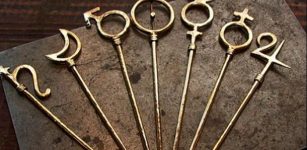 Number ‘Seven’: Mystical Number Of The Universe And One Of The Most Sacred Numbers
Ancient Symbols | Feb 14, 2017
Number ‘Seven’: Mystical Number Of The Universe And One Of The Most Sacred Numbers
Ancient Symbols | Feb 14, 2017 -
 How Was The 3,600-Year-Old Nebra Sky Disc Made? New Clues
Artifacts | Nov 29, 2024
How Was The 3,600-Year-Old Nebra Sky Disc Made? New Clues
Artifacts | Nov 29, 2024 -
 Lost Advanced Ancient Forest Civilization In The South West Pacific Could Re-Write History – Legends And Archaeological Findings Examined
Ancient Mysteries | Apr 25, 2018
Lost Advanced Ancient Forest Civilization In The South West Pacific Could Re-Write History – Legends And Archaeological Findings Examined
Ancient Mysteries | Apr 25, 2018 -
 Why Human Languages Can Be Likened To Branches On A Tree And Help Finding A Single Common Ancestor
Linguistic Discoveries | Sep 11, 2021
Why Human Languages Can Be Likened To Branches On A Tree And Help Finding A Single Common Ancestor
Linguistic Discoveries | Sep 11, 2021 -
 Identity Of Anti-Christ And Number 666 Revealed By Ancient History Professor
Archaeology | Apr 6, 2019
Identity Of Anti-Christ And Number 666 Revealed By Ancient History Professor
Archaeology | Apr 6, 2019 -
 New Clues May Explain Collapse Of Ancient City Teotihuacan In Mexico
Archaeology | Sep 22, 2022
New Clues May Explain Collapse Of Ancient City Teotihuacan In Mexico
Archaeology | Sep 22, 2022 -
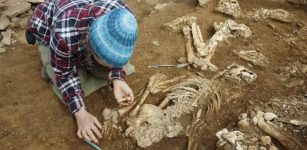 Riddle Of Orkney’s Lost Tomb – Fascinating Neolithic Discovery
Featured Stories | Nov 15, 2023
Riddle Of Orkney’s Lost Tomb – Fascinating Neolithic Discovery
Featured Stories | Nov 15, 2023 -
 Zeus – ‘Cloud Collector’, God Of Order, Law And Justice – Most Powerful God Of Olympian Pantheon
Featured Stories | Jan 3, 2019
Zeus – ‘Cloud Collector’, God Of Order, Law And Justice – Most Powerful God Of Olympian Pantheon
Featured Stories | Jan 3, 2019 -
 Human Ancestors Preferred Mosaic Landscapes And High Ecosystem Diversity – New Study
Evolution | May 13, 2023
Human Ancestors Preferred Mosaic Landscapes And High Ecosystem Diversity – New Study
Evolution | May 13, 2023 -
 Disbelief In Human Evolution Is Linked To Prejudice And Racism – Scientists Say
Human Beginnings | Apr 5, 2022
Disbelief In Human Evolution Is Linked To Prejudice And Racism – Scientists Say
Human Beginnings | Apr 5, 2022 -
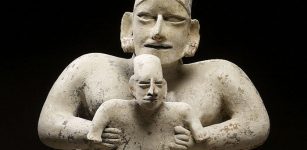 Ancient Mothers Cared For Kids Better Than Previously Thought
Archaeology | Nov 29, 2021
Ancient Mothers Cared For Kids Better Than Previously Thought
Archaeology | Nov 29, 2021 -
 On This Day In History: Papal Bull Issued To Arrest All Knights Templar And Seize Their Lands – On 22 Nov, 1307
News | Nov 22, 2016
On This Day In History: Papal Bull Issued To Arrest All Knights Templar And Seize Their Lands – On 22 Nov, 1307
News | Nov 22, 2016 -
 Oldest Giant Dinosaur Species Discovered In Argentina
Archaeology | Jul 10, 2018
Oldest Giant Dinosaur Species Discovered In Argentina
Archaeology | Jul 10, 2018 -
 Mysterious Skeletons Of A Tall Unknown Race Discovered In California – Who Were These Beings?
Featured Stories | Apr 10, 2024
Mysterious Skeletons Of A Tall Unknown Race Discovered In California – Who Were These Beings?
Featured Stories | Apr 10, 2024 -
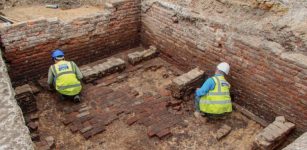 London’s Oldest Theater Red Lion Discovered Beneath Whitechapel
Archaeology | Jun 10, 2020
London’s Oldest Theater Red Lion Discovered Beneath Whitechapel
Archaeology | Jun 10, 2020 -
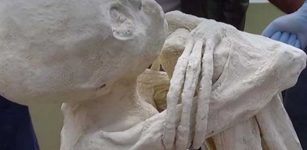 Mystery Of Nazca’s Controversial Three-Fingered Mummies Continues – Attempt To Confiscate The Ancient Remains!
Archaeology | Oct 26, 2019
Mystery Of Nazca’s Controversial Three-Fingered Mummies Continues – Attempt To Confiscate The Ancient Remains!
Archaeology | Oct 26, 2019 -
 Diet And Social Changes In Central Europe Around 1500 BC
Archaeology | Jun 12, 2025
Diet And Social Changes In Central Europe Around 1500 BC
Archaeology | Jun 12, 2025 -
 Unique Ancient Roman Boxing Gloves Discovered Near Hadrian’s Wall – The Only Surviving Example From 120 A.D.
Archaeology | Feb 20, 2018
Unique Ancient Roman Boxing Gloves Discovered Near Hadrian’s Wall – The Only Surviving Example From 120 A.D.
Archaeology | Feb 20, 2018 -
 Two Vikings From The Same Family Reunited After 1,000 Years
Archaeology | Jun 15, 2021
Two Vikings From The Same Family Reunited After 1,000 Years
Archaeology | Jun 15, 2021 -
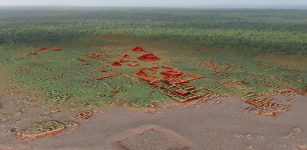 LIDAR Reveals Secrets Of The Enormous Ancient Maya City Of Calakmul
Archaeology | Oct 31, 2022
LIDAR Reveals Secrets Of The Enormous Ancient Maya City Of Calakmul
Archaeology | Oct 31, 2022


